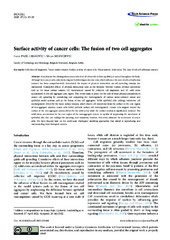Surface activity of cancer cells: The fusion of two cell aggregates
Чланак у часопису (Објављена верзија)
Метаподаци
Приказ свих података о документуАпстракт
A key feature that distinguishes cancer cells from all other cells is their capability to spread throughout the body. Although how cancer cells collectively migrate by following molecular rules which influence the state of cell-cell adhesion contacts has been comprehensively formulated, the impact of physical interactions on cell spreading remains less understood. Cumulative effects of physical interactions exist as the interplay between various physical parameters such as (1) tissue surface tension, (2) viscoelasticity caused by collective cell migration, and (3) solid stress accumulated in the cell aggregate core region. This review aims to point out the role of these physical parameters in cancer cell spreading by considering and comparing the rearrangement of various mono-cultured cancer and epithelial model systems such as the fusion of two cell aggregates. While epithelial cells undergo volumetric cell rearrangement driven by the tissue surface tension, which directs cell movemen...t from the surface to the core region of two-aggregate systems, cancer cells rather perform surface cell rearrangement. Cancer cells migrate toward the surface of the two-aggregate system driven by the solid stress while the surface tension is significantly reduced. The solid stress, accumulated in the core region of the two-aggregate system, is capable of suppressing the movement of epithelial cells that can undergo the jamming state transition; however, this stress enhances the movement of cancer cells. We have focused here on the multi-scale rheological modeling approaches that aimed at reproducing and understanding these biological systems.
Кључне речи:
Collective cell migration / Solid stress / Surface activity of cancer cells / The state of cell-cell adhesion contacts / Tissue surface tension / ViscoelasticityИзвор:
Biocell, 2023, 47, 1, 15-25Издавач:
- Tech Science Press
Финансирање / пројекти:
- Министарство науке, технолошког развоја и иновација Републике Србије, институционално финансирање - 200135 (Универзитет у Београду, Технолошко-металуршки факултет) (RS-MESTD-inst-2020-200135)
Институција/група
Tehnološko-metalurški fakultetTY - JOUR AU - Pajić-Lijaković, Ivana AU - Milivojević, Milan PY - 2023 UR - http://TechnoRep.tmf.bg.ac.rs/handle/123456789/5287 AB - A key feature that distinguishes cancer cells from all other cells is their capability to spread throughout the body. Although how cancer cells collectively migrate by following molecular rules which influence the state of cell-cell adhesion contacts has been comprehensively formulated, the impact of physical interactions on cell spreading remains less understood. Cumulative effects of physical interactions exist as the interplay between various physical parameters such as (1) tissue surface tension, (2) viscoelasticity caused by collective cell migration, and (3) solid stress accumulated in the cell aggregate core region. This review aims to point out the role of these physical parameters in cancer cell spreading by considering and comparing the rearrangement of various mono-cultured cancer and epithelial model systems such as the fusion of two cell aggregates. While epithelial cells undergo volumetric cell rearrangement driven by the tissue surface tension, which directs cell movement from the surface to the core region of two-aggregate systems, cancer cells rather perform surface cell rearrangement. Cancer cells migrate toward the surface of the two-aggregate system driven by the solid stress while the surface tension is significantly reduced. The solid stress, accumulated in the core region of the two-aggregate system, is capable of suppressing the movement of epithelial cells that can undergo the jamming state transition; however, this stress enhances the movement of cancer cells. We have focused here on the multi-scale rheological modeling approaches that aimed at reproducing and understanding these biological systems. PB - Tech Science Press T2 - Biocell T1 - Surface activity of cancer cells: The fusion of two cell aggregates EP - 25 IS - 1 SP - 15 VL - 47 DO - 10.32604/biocell.2023.023469 ER -
@article{
author = "Pajić-Lijaković, Ivana and Milivojević, Milan",
year = "2023",
abstract = "A key feature that distinguishes cancer cells from all other cells is their capability to spread throughout the body. Although how cancer cells collectively migrate by following molecular rules which influence the state of cell-cell adhesion contacts has been comprehensively formulated, the impact of physical interactions on cell spreading remains less understood. Cumulative effects of physical interactions exist as the interplay between various physical parameters such as (1) tissue surface tension, (2) viscoelasticity caused by collective cell migration, and (3) solid stress accumulated in the cell aggregate core region. This review aims to point out the role of these physical parameters in cancer cell spreading by considering and comparing the rearrangement of various mono-cultured cancer and epithelial model systems such as the fusion of two cell aggregates. While epithelial cells undergo volumetric cell rearrangement driven by the tissue surface tension, which directs cell movement from the surface to the core region of two-aggregate systems, cancer cells rather perform surface cell rearrangement. Cancer cells migrate toward the surface of the two-aggregate system driven by the solid stress while the surface tension is significantly reduced. The solid stress, accumulated in the core region of the two-aggregate system, is capable of suppressing the movement of epithelial cells that can undergo the jamming state transition; however, this stress enhances the movement of cancer cells. We have focused here on the multi-scale rheological modeling approaches that aimed at reproducing and understanding these biological systems.",
publisher = "Tech Science Press",
journal = "Biocell",
title = "Surface activity of cancer cells: The fusion of two cell aggregates",
pages = "25-15",
number = "1",
volume = "47",
doi = "10.32604/biocell.2023.023469"
}
Pajić-Lijaković, I.,& Milivojević, M.. (2023). Surface activity of cancer cells: The fusion of two cell aggregates. in Biocell Tech Science Press., 47(1), 15-25. https://doi.org/10.32604/biocell.2023.023469
Pajić-Lijaković I, Milivojević M. Surface activity of cancer cells: The fusion of two cell aggregates. in Biocell. 2023;47(1):15-25. doi:10.32604/biocell.2023.023469 .
Pajić-Lijaković, Ivana, Milivojević, Milan, "Surface activity of cancer cells: The fusion of two cell aggregates" in Biocell, 47, no. 1 (2023):15-25, https://doi.org/10.32604/biocell.2023.023469 . .



